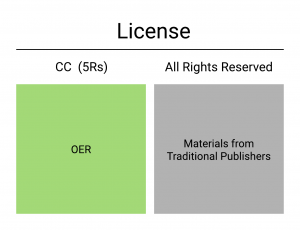For the first decade of the modern open education movement (1998 – 2007), the distinguishing feature of our work – the thing we cared most about and talked most about – was the open licensing we applied to educational materials. MIT OCW, CMU OLI, Rice’s Connexions, my group at USU, and others applied the new Creative Commons licenses to their materials to create open content. UNESCO later decided to refer to open content intended to support research, teaching, and learning as “open educational resources.” There were two kinds of educational materials in the world. They were relatively easy to tell apart from one another and advocacy was rather straight forward. As the movement grew and more people began advocating for the adoption of OER in place of traditionally copyrighted materials in classes, some advocates chose to make cost the primary focus of their advocacy. This choice rotated licensing into a secondary priority. Now with two criteria to attend to (cost and licensing), there were twice as many types of materials to think about, advocate for, and advocate against. In its simplest form, the four types of materials can be characterized as follows:
As the movement grew and more people began advocating for the adoption of OER in place of traditionally copyrighted materials in classes, some advocates chose to make cost the primary focus of their advocacy. This choice rotated licensing into a secondary priority. Now with two criteria to attend to (cost and licensing), there were twice as many types of materials to think about, advocate for, and advocate against. In its simplest form, the four types of materials can be characterized as follows:
- Materials that were traditionally copyrighted and not free were the textbooks we had all grown up complaining about. (grey below)
- Materials that were openly licensed and free were the OER we had spent the last decade advocating for. (green below)
- Materials that were traditionally copyrighted and “free” to students (in reality, paid for with a portion of student fees) were the research journals, monographs, books, and other resources our libraries purchase or subscribe to. Over 99% of the web fits into this category (YouTube, CNN, etc.). (yellow below)
- Materials that were openly licensed and not free, including openly licensed content in print and in courseware formats. (blue below)
 During the second decade, advocates who were primarily focused on cost developed new language to talk about their work: Zero Textbook Cost (ZTC). As the above diagram shows, ZTC and OER advocates share common ground (green above), but also have important differences driven by their primary priorities. As people advocate for one priority over the other, this advocacy often ends up becoming formalized in policies and programs. For example, some schools have ZTC policies and ZTC degree programs. These policies often prohibit the adoption of OER in the courseware context (blue above) because of the greater than $0 costs associated with things like online homework systems. Other schools have OER policies and OER degree programs. These policies often discourage the adoption of library resources or other web-based resources (yellow above) because they are not openly licensed.
During the second decade, advocates who were primarily focused on cost developed new language to talk about their work: Zero Textbook Cost (ZTC). As the above diagram shows, ZTC and OER advocates share common ground (green above), but also have important differences driven by their primary priorities. As people advocate for one priority over the other, this advocacy often ends up becoming formalized in policies and programs. For example, some schools have ZTC policies and ZTC degree programs. These policies often prohibit the adoption of OER in the courseware context (blue above) because of the greater than $0 costs associated with things like online homework systems. Other schools have OER policies and OER degree programs. These policies often discourage the adoption of library resources or other web-based resources (yellow above) because they are not openly licensed.
A few observations about the OER and ZTC work.
- The OER row, with its inclusion of OER integrated into courseware, likely appeals to people in STEM disciplines where lots of practice is called for and it’s easier to design systems that can provide infinite practice, automatically grade that practice, and provide diagnostic feedback. These classes likely have little focus on asking students to read specific articles – any of a thousand explanations of the second law of thermodynamics or the central limit theorem will do the job.
- The ZTC column, with its inclusion of traditionally copyrighted materials in the library collection, likely appeals to people in the humanities that want students to study specific works of art and other cultural artifacts – where sentences like “we’ll just read an open source equivalent of Catcher in the Rye” don’t make any sense. These classes likely have little focus on asking students to engage in the kind of repeated practice that can be computer generated and computer graded.
- The OER row, with its focus on open licensing, likely appeals to people who came to the movement because they’re interested in the pedagogical innovation facilitated by the 5R affordances of open content. None of that is possible with free but traditionally copyrighted content.
- The ZTC column, with its literal prohibition on students paying anything for course materials, likely appeals to people who feel that allowing there to be any costs associated with course materials makes future price increases and an eventually return to today’s immorally high prices all but inevitable.
Regardless of whether you feel a stronger affinity with the ZTC camp or the OER camp, there is something we should all strive to remember. Our primary priority should neither be minimizing cost nor maximizing pedagogical flexibility. Our primary priority should be increasing student learning, and our efforts to reduce costs and increase pedagogical flexibility must always be subservient to that end. When we fail to put student learning first, we can become zealots who confuse the means with the ends. This makes it possible for us to pursue cost reduction at any price to student learning. It also makes it possible for us to pursue pedagogical flexibility regardless of the cost to student learning.
There’s no reason why faculty and institutions can’t leverage all three of the green, yellow, and blue boxes above in support student learning. The false, forced choice between ZTC and OER evaporates when we put student learning first. If we want to provide viable course materials options for all faculty and for all courses, we’re going to need to get a lot smarter about how we legally and effectively compile, revise, and remix these different kinds of materials.
You’re never going to be able teach Contemporary British Literature as a 100% OER course. It’s not just hard – it’s literally not possible. But there’s a lot of OER goodness that can be wrapped around the outside of the All Rights Reserved novels and other readings that sit in the middle of that course.
Likewise, you’re never going to persuade faculty to go back to teaching College Algebra using an openly licensed PDF or printed text without the support of an online homework system. They’re just not going back to a world where they have to grade 30 homework problems per student by hand three times a week.
A more expansive view is possible – and necessary.

Moke Lake Milky Way by Paul Stewart is licensed CC 0.
Comments are closed.